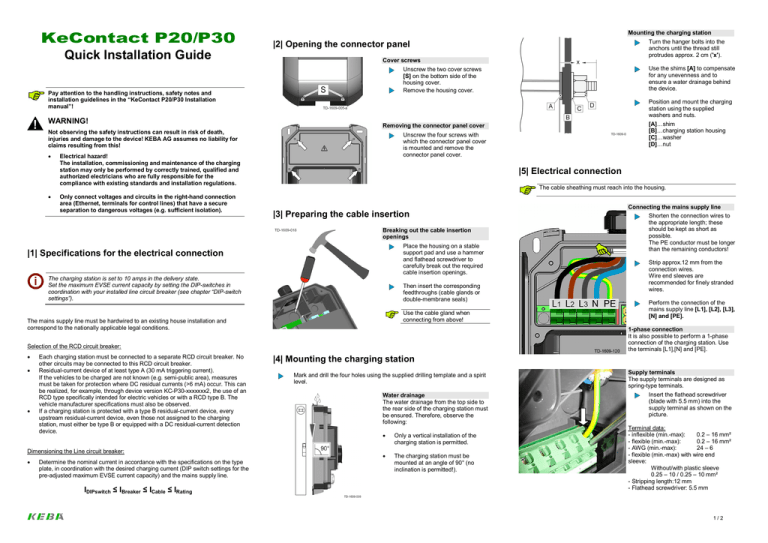
KeContact P20/P30
Quick Installation Guide
Mounting the charging station
Cover screws
WARNING!
Not observing the safety instructions can result in risk of death,
injuries and damage to the device! KEBA AG assumes no liability for
claims resulting from this!
·
·
Position and mount the charging
station using the supplied
washers and nuts.
Unscrew the four screws with
which the connector panel cover
is mounted and remove the
connector panel cover.
|5| Electrical connection
The cable sheathing must reach into the housing.
|3| Preparing the cable insertion
Breaking out the cable insertion
openings
Place the housing on a stable
support pad and use a hammer
and flathead screwdriver to
carefully break out the required
cable insertion openings.
|1| Specifications for the electrical connection
The charging station is set to 10 amps in the delivery state.
Set the maximum EVSE current capacity by setting the DIP-switches in
coordination with your installed line circuit breaker (see chapter “DIP-switch
settings”).
Then insert the corresponding
feedthroughs (cable glands or
double-membrane seals)
Use the cable gland when
connecting from above!
The mains supply line must be hardwired to an existing house installation and
correspond to the nationally applicable legal conditions.
·
·
Each charging station must be connected to a separate RCD circuit breaker. No
other circuits may be connected to this RCD circuit breaker.
Residual-current device of at least type A (30 mA triggering current).
If the vehicles to be charged are not known (e.g. semi-public area), measures
must be taken for protection where DC residual currents (>6 mA) occur. This can
be realized, for example, through device version KC-P30-xxxxxxx2, the use of an
RCD type specifically intended for electric vehicles or with a RCD type B. The
vehicle manufacturer specifications must also be observed.
If a charging station is protected with a type B residual-current device, every
upstream residual-current device, even those not assigned to the charging
station, must either be type B or equipped with a DC residual-current detection
device.
Dimensioning the Line circuit breaker:
·
Determine the nominal current in accordance with the specifications on the type
plate, in coordination with the desired charging current (DIP switch settings for the
pre-adjusted maximum EVSE current capacity) and the mains supply line.
IDIPswitch ≤ IBreaker ≤ ICable ≤ IRating
Connecting the mains supply line
Shorten the connection wires to
the appropriate length; these
should be kept as short as
possible.
The PE conductor must be longer
than the remaining conductors!
Strip approx.12 mm from the
connection wires.
Wire end sleeves are
recommended for finely stranded
wires.
Perform the connection of the
mains supply line [L1], [L2], [L3],
[N] and [PE].
1-phase connection
It is also possible to perform a 1-phase
connection of the charging station. Use
the terminals [L1],[N] and [PE].
Selection of the RCD circuit breaker:
·
[A]…shim
[B]…charging station housing
[C]…washer
[D]…nut
Removing the connector panel cover
Electrical hazard!
The installation, commissioning and maintenance of the charging
station may only be performed by correctly trained, qualified and
authorized electricians who are fully responsible for the
compliance with existing standards and installation regulations.
Only connect voltages and circuits in the right-hand connection
area (Ethernet, terminals for control lines) that have a secure
separation to dangerous voltages (e.g. sufficient isolation).
Use the shims [A] to compensate
for any unevenness and to
ensure a water drainage behind
the device.
Unscrew the two cover screws
[S] on the bottom side of the
housing cover.
Remove the housing cover.
Pay attention to the handling instructions, safety notes and
installation guidelines in the “KeContact P20/P30 Installation
manual”!
!
Turn the hanger bolts into the
anchors until the thread still
protrudes approx. 2 cm ('x').
|2| Opening the connector panel
|4| Mounting the charging station
Mark and drill the four holes using the supplied drilling template and a spirit
level.
Water drainage
The water drainage from the top side to
the rear side of the charging station must
be ensured. Therefore, observe the
following:
·
Only a vertical installation of the
charging station is permitted.
·
The charging station must be
mounted at an angle of 90° (no
inclination is permitted!).
Supply terminals
The supply terminals are designed as
spring-type terminals.
Insert the flathead screwdriver
(blade with 5.5 mm) into the
supply terminal as shown on the
picture.
Terminal data:
- inflexible (min.-max):
0.2 – 16 mm²
- flexible (min.-max):
0.2 – 16 mm²
- AWG (min.-max):
24 – 6
- flexible (min.-max) with wire end
sleeve:
Without/with plastic sleeve
0.25 – 10 / 0.25 – 10 mm²
- Stripping length:12 mm
- Flathead screwdriver: 5.5 mm
1/2
|6| DIP-switch settings
|7| General commissioning process
Position of the DIP-switches DSW1/2
[DSW1]…configuration
[DSW2]…addressing
Amperage settings with DSW1
1.
Remove all residual installation and connection materials from the connection
area.
2.
Before commissioning, check all screw and terminal connections for firm seating!
3.
Check whether all unused cable glands are properly sealed with blind plugs or
dummy screw fittings.
4.
Ensure that the voltage of the mains supply line is switched on.
After 15 to 20 seconds, the status LED must flash green slowly.
The device performs a self test every time it is switched on.
5.
Perform the specified initial tests according to the locally applicable regulations
and laws.
6.
Close the connector panel cover to the charging station.
7.
Mount the housing cover.
|8| Closing the Wallbox
Housing mark
Tighten the four screws until the
mark on the connector panel
cover is even with the housing
surface.
The connector panel cover must
seal the housing properly.
Example setting for 16A.
Commissioning mode
Fitting the housing cover
Fit the housing cover at the top
and push the cover downwards
slightly.
The charging station can be placed into a commissioning mode for supporting the
initial system test. During this, a self-test of the device is performed (interlocking,
contactor activation, current measurement, etc.) and the result is displayed.
SETTING THE AMPERAGE (DSW1) (*1)
Curr
ent
D1.6
D1.7
D1.8
Figure
Make sure that the housing cover
is seated correctly at the top in
the housing guides.
After successful test without connected vehicle, the contactor is switched for limited
time in order to facilitate the initial tests. A normal charging procedure is not possible
in commissioning mode. The interlocking of the connector socket is activated to
prevent a cable from being plugged in.
Min. cable
cross
section
Switching on the charging station in commissioning mode via the supply voltage leads
for security reasons in an error state (white-red-red-red) to prevent an unattended
activation.
≥ 1.5 mm²
Activating the commissioning mode
Cover screws
10A
OFF
OFF
OFF
Secure the housing cover at the
bottom using the two cover
screws [S].
Set the DIP-switch DSW2.8 to ON.
Perform a reset of the charging station. To do this press the [Service
button] for 1 second.
13A
16A
ON
OFF
OFF
ON
OFF
OFF
≥ 1.5 mm²
≥ 2.5 mm²
The commissioning mode is now activated and is indicated by the orange
status LED (lights continuously).
You now have the option for approximately 5 min. to contact with standard
test probes using the measuring device ( e.g. Astaco® test probes from
BEHA) and to perform the necessary tests.
After 5 min. have elapsed, the contactor is deactivated in the charging
station is shut down.
20A
ON
ON
OFF
≥ 2.5 mm²
Deactivating the commissioning mode
Set the DIP-switch DSW2.8 to
OFF again.
25A
32A
OFF
ON
OFF
OFF
ON
ON
Perform a reset of the charging
station. To do this, press the
[Service button] for 1 second or
switch the power supply voltage
off/on.
≥ 4.0 mm²
≥ 6.0 mm²
DSW2.8 = OFF
(*1) Preadjusted maximum current value for the EV charger (control pilot duty cycle).
■…Indicates the position where to push down the DIP switch.
The charging station starts up
again in normal mode and is
ready for operation.
© KEBA 2014-2016
Subject to alteration in the course of technical advancement. No guarantee is offered for the
accuracy of the information provided. All rights reserved.
All brand and product names are trademarks of their respective companies. Technical
information in this document is subject to change without notice.
Document: Revision 2.00 / Release date: 02.03.2016 / Article no.: 93408
KEBA AG, Postfach 111, Gewerbepark Urfahr, A-4041 Linz; www.kecontact.com
2/2




